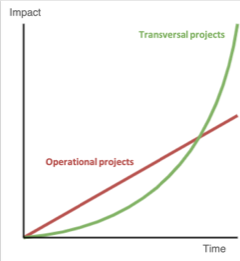“Take the first person you see when arriving at the office: the office manager. Is their presence justified by operational imperatives (supplying coffee for the coffee machine, toilet paper for the toilets, pens for the pen jars, etc.) or by their big-picture perspective of the teams, which allows them to make the office a site of employee engagement?”
When a company moves from start-up to scale-up, those who are a jack-of-all-trades run the risk of losing their value. The vision of the whole, crucial for understanding high-level issues, gets lost in the search for specialised profiles. Such expertise is vital in a large number of areas, but let’s take marketing as an example. Like the office manager above, the work of marketers is seen in different ways depending on who you talk to. Transcending the operational vision of marketers means enabling measures of success that go beyond standard metrics.
To specialise or not to specialise
Specialists will excel in their area of expertise, to the detriment of secondary fields – we cannot excel everywhere (and would we want to?). However, it would seem that this presents a challenge for companies undergoing transformation. What should we expect from teams working at companies experiencing rapid growth or pivoting from one area of activity to another?
There is no clear answer when it comes to risk management. Two options sit in opposition to each other, requiring us to reflect on both managerial and strategic implications. Do you want to hire the specialist with underdeveloped side talents who excels in their main skill area (optimisation threshold), or the cross-functional talent with no specific area of expertise but with good global knowledge in his or her discipline (acceptability threshold)?
To draw a parallel with education, should one professional worker aim for three bachelors’ degrees in different disciplines, or deep-dive until reaching a best-in-class, internationally recognised Ph.D.? We should ask ourselves if the bachelors’ degrees are enough to be recognised as an expert by their peers. This reaches the acceptability threshold. To become an expert, the Ph.D. may be the optimisation threshold as it is widely recognised as the highest level in a particular area.
Ever since it was created, marketing has been searching for its identity as a field. This means that the huge variety of individuals and teams who are supposed to provide a foundation of common skills find themselves without a clear consensus.
Knowing how to do something, like a craftsman, is different from knowing how to make connections, mobilising different skills and teams to successfully complete a project.
The versatile marketer
The often debated difference resides in the acceptability threshold: versatile candidates aim to and may appear to have mastered multiple specialisations. In the case of marketing, it is not necessarily an advantage to be an expert in multiple areas (nor is it likely to be possible). It may be more important to have analytical skills and big-picture thinking, in order to construct a multichannel strategy for a product, rather than be able to perfectly execute a task. In 2022, everything is about interconnections. Knowing how to do something, like a craftsman, is different from knowing how to make connections, mobilising different skills and teams to successfully complete a project.
Specialisation and cross-functionality: two approaches in service of operations?
Specialisation is often seen as the opposite of cross-functionality. And yet, both serve a common aim: operational efficiency. Such efficiency is critical for both large and small companies, as it involves maximising an employee’s immediate return on investment (ROI).
In a small company, a cross-functional or versatile marketer may be able to launch digital paid acquisition campaigns, do SEO for a website, set up content marketing initiatives, and more. As for specialised marketers, they will be able to optimise one of these projects. It is purely a question of operational vision in service of managerial objectives.
Nearly 80 percent of digitally maturing entities reward cross-functional collaboration versus only 34 percent of companies at early stages of digital development.
Digital Business Dissolves Silos, Deloitte for The Wall Street Journal
Is impact the key to the debate?
Cross-functional profiles are exposed to a large number of seemingly useful trade-oriented solutions – with functions that may seem essential at a certain moment in time but whose impact in the medium term is questionable.
Hyperspecialised profiles risk overly restricting their toolbox to correspond to their own skills rather than the company’s interest.
While tools are at the heart of a marketer’s arsenal, measuring the impact of their initiatives plays a far more important role. It makes it possible to quantify communication needs at a macro level in order to achieve objectives set by the highest levels of company management.
The difficulty that many marketers face is the inability to take this macro view, which is needed to measure impact. The continuous flow of company objectives may cause employee missions to lose meaning, as they are not directly connected to the company vision. Cross-functionality can assist in this search for impact: if the communication team’s objectives are not immediately linked to the marketer’s missions, the latter must move towards these objectives.
When missions are shared between departments, the loop is closed – an overall view of operational objectives gives the marketer an opportunity to impact high-level objectives by establishing a strategy based on the stage of the product life cycle.
However, such cases require greater patience as regards ROI. Siloed operational projects and missions will be more efficient for a certain time. The diagram to the right does not show specific measures of time or impact, as these factors are specific to each company – but succinctly illustrates the idea discussed.

Cross-functionality helps to provide a clear vision of utilitarian values
Cross-functionality prioritises impact-based objectives over quantifiable operational objectives. This means it forces marketers to be rigorous in project management. They can also greatly benefit from so-called “agile” methodologies, which, beyond the project management aspect, place the end user at the heart of issues and decisions.
This is precisely the strength of cross-functional marketers: by connecting different issues at a horizontal level, they can develop a vision that’s both customer AND user-centric, while remaining fully aware of operational challenges, as well as the utilitarian value of the strategy.
For retailers to synchronise multiple, complementary channel strategies it is necessary to understand the specific relationship between the utilitarian values consumers derive from each channel.
Stephanie M. Noble, Consumer derived utilitarian value and channel utilisation in a multi-channel retail context, 2005
By using a cross-functional strategy, marketers remain aware of the range of issues within a single initiative
Thanks to this horizontal vision, communication strategies will not only be capable of anticipating multiple factors (for example, a new product functionality automatically causing a rise in IT support requests) but also of allowing for measures of success that go beyond the standard metrics. Marketers, therefore, hold a central position in user engagement, at the intersection of marketing and human resources.
What if the key to every action was to above all understand the impact on internal teams, to ensure good external adoption? For a marketer, impact should be searched for in both business benefits and the operational pressure it puts on teams. Thinking cross-functionally is key to ensuring initiatives are able to scale.

Julien Hervy is a strategy consultant and customer experience (CX) specialist. A graduate from ESCP Business School in 2014, Julien helps companies from different sectors with their CX strategy: from conception of experiences and customer journeys to the measurement of customers’ perceptions. With clients in France, Germany, the US and Canada, he supports organisations at the international level in their transformation towards a more customer-centric vision. He set standards for CX strategy and Feedback Management with major institutions in France and he now leads training on CX, leadership and management with senior executives and managers.

Quentin Berthommier is a user engagement specialist. My objective is to positively impact the perception and perceived value of products, with the help of multichannel communication strategies.
Quentin works with Julien Hervy – strategic consultant, ESCP 2014 – on marketing and communication projects. They both aim to collaborate to understand and optimise marketing strategies connected with leadership, customer experience and community management (customer and employee).
License and Republishing
The Choice - Republishing rules
We publish under a Creative Commons license with the following characteristics Attribution/Sharealike.
- You may not make any changes to the articles published on our site, except for dates, locations (according to the news, if necessary), and your editorial policy. The content must be reproduced and represented by the licensee as published by The Choice, without any cuts, additions, insertions, reductions, alterations or any other modifications.If changes are planned in the text, they must be made in agreement with the author before publication.
- Please make sure to cite the authors of the articles, ideally at the beginning of your republication.
- It is mandatory to cite The Choice and include a link to its homepage or the URL of thearticle. Insertion of The Choice’s logo is highly recommended.
- The sale of our articles in a separate way, in their entirety or in extracts, is not allowed , but you can publish them on pages including advertisements.
- Please request permission before republishing any of the images or pictures contained in our articles. Some of them are not available for republishing without authorization and payment. Please check the terms available in the image caption. However, it is possible to remove images or pictures used by The Choice or replace them with your own.
- Systematic and/or complete republication of the articles and content available on The Choice is prohibited.
- Republishing The Choice articles on a site whose access is entirely available by payment or by subscription is prohibited.
- For websites where access to digital content is restricted by a paywall, republication of The Choice articles, in their entirety, must be on the open access portion of those sites.
- The Choice reserves the right to enter into separate written agreements for the republication of its articles, under the non-exclusive Creative Commons licenses and with the permission of the authors. Please contact The Choice if you are interested at contact@the-choice.org.
Individual cases
Extracts: It is recommended that after republishing the first few lines or a paragraph of an article, you indicate "The entire article is available on ESCP’s media, The Choice" with a link to the article.
Citations: Citations of articles written by authors from The Choice should include a link to the URL of the authors’ article.
Translations: Translations may be considered modifications under The Choice's Creative Commons license, therefore these are not permitted without the approval of the article's author.
Modifications: Modifications are not permitted under the Creative Commons license of The Choice. However, authors may be contacted for authorization, prior to any publication, where a modification is planned. Without express consent, The Choice is not bound by any changes made to its content when republished.
Authorized connections / copyright assignment forms: Their use is not necessary as long as the republishing rules of this article are respected.
Print: The Choice articles can be republished according to the rules mentioned above, without the need to include the view counter and links in a printed version.
If you choose this option, please send an image of the republished article to The Choice team so that the author can review it.
Podcasts and videos: Videos and podcasts whose copyrights belong to The Choice are also under a Creative Commons license. Therefore, the same republishing rules apply to them.





